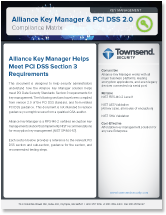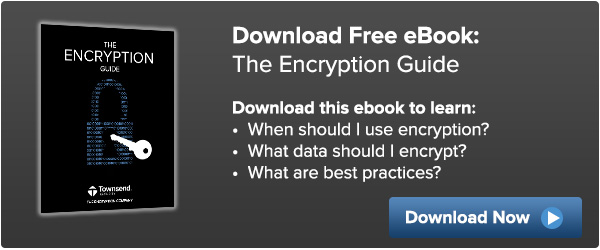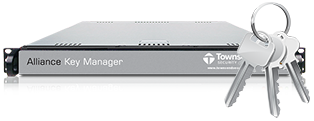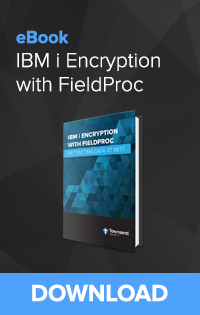DOWNLOAD WHITE PAPER |
Level 1 merchants are doing pretty well meeting the data security requirements because they’ve been through several cycles of on-site QSA audits. With the basic security controls in place, they are focusing on implementing better real-time monitoring and learning to react quickly to new threats. We still see breaches among large retailers because the bad guys are getting better, but the larger merchants have really stepped up their game.
The picture is not so bright with Level 2 and Level 3 merchants. Level 2 merchants now have to undergo an on-site QSA audit, or do annual training with a PCI SSC certified trainer. This is having a big impact on a lot of these merchants whose security controls were not up to par. They are having to deploy better monitoring systems, and meet industry best practices for encryption and key management. And key management is turning out to be a problem area from many of these mid-tier merchants.
What are the key management problems that I am hearing about? Here are some examples:
- A retailer with an eCommerce web site running on a Windows platform is encrypting data in a SQL Server database, but the key is stored on another server in the clear. A QSA auditor required that the merchant deploy better key management practices.
- A large manufacturer runs a user group and collects membership fees from a web site which are then processed on an IBM System i (AS/400) platform. The encryption keys were stored in encrypted format on the same server. A QSA auditor at their payment processor required that they institute better key management practices by storing the keys in an HSM on a physically separate server.
- A division of a large home improvement retail chain accepted customer orders from a web site, and processed the authorization transactions on a Linux server. The encryption keys were stored on a removable storage device. The payment processor rejected their self-assessment questionnaire on the basis of key management practices. The division migrated to the corporate key management solution to mitigate the issue.
- A software vendor who provides web hotel reservation portals uses both a Windows application and a Linux application to process reservation requests and payments. PCI standards require that credit card numbers be encrypted as data moves through both server environments. This software developer had good advice and chose a defensible key management strategy from the start.
I think you get the idea. Starting with a good key management solution is going to save you some grief later. We helped each of these companies meet PCI DSS compliance for key management, and in most cases it really didn’t take that much time or effort. But better to get it right from the start!
To learn more, download our white paper on encryption key management requirements for PCI.



 Many of you have asked me about encryption and key management requirements for HIPAA and HITECH Act. I can understand why there is a fair amount of confusion about this. The US Department of Health and Human Services (HHS) has not issued the final rules, but they have indicated that the current Interim Final Rules are unlikely to change very much. The final rules are due to be published later this year, and may be updated on an annual basis.
Many of you have asked me about encryption and key management requirements for HIPAA and HITECH Act. I can understand why there is a fair amount of confusion about this. The US Department of Health and Human Services (HHS) has not issued the final rules, but they have indicated that the current Interim Final Rules are unlikely to change very much. The final rules are due to be published later this year, and may be updated on an annual basis.
 Earlier this month we announced that we became a silver level business intelligence partner with Microsoft. This new alliance will help us with the launch of our encryption key management solution for Microsoft SQL Server 2008, later this quarter. We just returned from Microsoft’s Worldwide Partner Conference where we met with several different partners about this opportunity. We talked with many companies who had similar interests in compliance and data protection, it was a great introduction into a new community that is very important to us.
Earlier this month we announced that we became a silver level business intelligence partner with Microsoft. This new alliance will help us with the launch of our encryption key management solution for Microsoft SQL Server 2008, later this quarter. We just returned from Microsoft’s Worldwide Partner Conference where we met with several different partners about this opportunity. We talked with many companies who had similar interests in compliance and data protection, it was a great introduction into a new community that is very important to us.


 Much like going to the gym, not many people wake up in the morning and say that they want to start an encryption project. It can take a little knowledge and some hard work to be done correctly. But the results of both provide benefits far beyond their initial investment.
Much like going to the gym, not many people wake up in the morning and say that they want to start an encryption project. It can take a little knowledge and some hard work to be done correctly. But the results of both provide benefits far beyond their initial investment.

 With the growing demand for regulatory compliance and concern for data privacy, organizations are taking advantage of encryption as a way to provide a "defense in depth" solution. This approach is often impractical using only database encryption management tools alone. Townsend Security has addressed this with their Alliance Key Manager Hardware Security Module (HSM). Alliance Key Manager is a FIPS 140-2 certified solution that stores encryption keys on a hardware appliance. This is a more secure approach and better meets compliance requirements because encryption keys do not reside with the encrypted data.
With the growing demand for regulatory compliance and concern for data privacy, organizations are taking advantage of encryption as a way to provide a "defense in depth" solution. This approach is often impractical using only database encryption management tools alone. Townsend Security has addressed this with their Alliance Key Manager Hardware Security Module (HSM). Alliance Key Manager is a FIPS 140-2 certified solution that stores encryption keys on a hardware appliance. This is a more secure approach and better meets compliance requirements because encryption keys do not reside with the encrypted data.


 Last week we hosted a well-attended webinar titled "
Last week we hosted a well-attended webinar titled " As it turns out, the weakness, in these devices, was not in the actual AES encryption, but in the key management processes. All the affected vendors quickly released replacements or patches to fix the problem, which is the right thing to do. But it was fascinating to watch some of the responses to this problem. Many commentators complained that the FIPS-140 testing was faulty, or that FIPS-140 testing was irrelevant. The implication is that FIPS-140 does not really give you any assurance of security, and therefore, also by implication, that it is not important.
As it turns out, the weakness, in these devices, was not in the actual AES encryption, but in the key management processes. All the affected vendors quickly released replacements or patches to fix the problem, which is the right thing to do. But it was fascinating to watch some of the responses to this problem. Many commentators complained that the FIPS-140 testing was faulty, or that FIPS-140 testing was irrelevant. The implication is that FIPS-140 does not really give you any assurance of security, and therefore, also by implication, that it is not important. First, FIPS-140 certification is not a guarantee of security. It is an assurance that encryption and related security algorithms have been implemented in compliance with published standards, that an application uses good practices in exposing it’s operational interfaces, that start up tests validate that the application has not been modified or corrupted, that cryptographic material is not exposed in application logs or leaked to memory, and that an independent expert has reviewed the source code. Going through a FIPS-140 certification is a grueling process for an encryption vendor and almost always results in finding some issues that need to be addressed to make the product more secure. Companies that engage in FIPS-140 certifications produce better products, and become better security designers in the process.
First, FIPS-140 certification is not a guarantee of security. It is an assurance that encryption and related security algorithms have been implemented in compliance with published standards, that an application uses good practices in exposing it’s operational interfaces, that start up tests validate that the application has not been modified or corrupted, that cryptographic material is not exposed in application logs or leaked to memory, and that an independent expert has reviewed the source code. Going through a FIPS-140 certification is a grueling process for an encryption vendor and almost always results in finding some issues that need to be addressed to make the product more secure. Companies that engage in FIPS-140 certifications produce better products, and become better security designers in the process.
 When you stop to think about it, this makes perfect sense. If the world used a secret algorithm to encrypt data, if that algorithm were ever to be discovered then all the world’s data would be at risk. But if the key is the one-and-only secret that unlocks the data, then a compromised key only puts the data at risk that was encrypted with that particular key. All the other data that has been encrypted with other keys is still safe. This demonstrates both the wisdom of strong (and open) algorithms, but also the essential importance of strong key protection.
When you stop to think about it, this makes perfect sense. If the world used a secret algorithm to encrypt data, if that algorithm were ever to be discovered then all the world’s data would be at risk. But if the key is the one-and-only secret that unlocks the data, then a compromised key only puts the data at risk that was encrypted with that particular key. All the other data that has been encrypted with other keys is still safe. This demonstrates both the wisdom of strong (and open) algorithms, but also the essential importance of strong key protection. Many software vendors are beginning to recognize the value of certifications. Some claim certifications they don’t actually have (HINT: PCI does not certify encryption software) and some will use confusing language to infer they have achieved levels of certification they haven’t. Recently I visited a website that claimed (I’m paraphrasing):
Many software vendors are beginning to recognize the value of certifications. Some claim certifications they don’t actually have (HINT: PCI does not certify encryption software) and some will use confusing language to infer they have achieved levels of certification they haven’t. Recently I visited a website that claimed (I’m paraphrasing):
 The other night I went to my very first WLC meeting. WLC is apart of United Way, it stands for Women's Leadership Council. WLC’s mission is to positively impact the lives of women in our community by promoting self sufficiency and financial stability through philanthropy and community service.
The other night I went to my very first WLC meeting. WLC is apart of United Way, it stands for Women's Leadership Council. WLC’s mission is to positively impact the lives of women in our community by promoting self sufficiency and financial stability through philanthropy and community service.